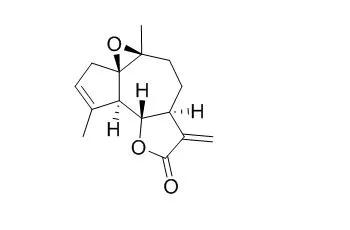| Description: |
Arglabin has antiatherogenic effects, it may represent a new promising compound to treat inflammation and type 2 diabetes mellitus development, it can attenuate inflammation, protect pancreatic β-cells from apoptosis, and prevent Type 2 diabetes mellitus development in ApoE2Ki mice on a chronic high-fat diet. Arglabin shows promising antitumor activity against different tumor cell lines, Arglabin-DMA inhibits cell proliferation of a variety of tumor types with IC(90)s in the range of 0.85 to 5.0 microg/ml. |
| Targets: |
IL Receptor | Bcl-2/Bax | Caspase | Autophagy |
| In vitro: |
| Oncol Rep. 2001 Jan-Feb;8(1):173-9. | | Arglabin-DMA, a plant derived sesquiterpene, inhibits farnesyltransferase.[Pubmed: 11115593] | Arglabin [1(R),10(S)-epoxy-5(S),5(S),7(S)-guaia-3(4),11(13)-dien-6, 12-olide], a sesquiterpene gamma-lactone is isolated from Artemisia glabella, a species of wormwood endemic to the Karaganda region of Kazakstan. The compound has been modified to render it water-soluble through addition of a dimethylaminohydrochloride group to the C(13) carbohydride moiety to yield Arglabin-DMA. Arglabin-DMA is a registered antitumor substance in the Republic of Kazakstan. Previously, we have shown that this compound prevents protein farnesylation without altering geranylgeranylation.
METHODS AND RESULTS:
We now report that Arglabin-DMA inhibits the incorporation of [(3)H]farnesylpyrophosphate into human H-ras protein by FTase with an IC(50) of no greater than 25 microM. Kinetic studies show that the phosphorylated form of this compound competitively inhibits the binding of farnesyl diphosphate to FTase.
This mechanism of action is different from other reported peptidomimetic FTIs which lower the affinity of ras protein to FTase.
CONCLUSIONS:
Our in vitro studies confirm that Arglabin-DMA inhibits post-translational modification of ras protein in cells. Arglabin-DMA inhibits anchorage-dependent proliferation of NB cells (IC50=10 microg/ml) and inhibits anchorage-independent growth of NB and KNRK cells with about the same IC(50). Soft-agar colony formation assay of H-ras and K-ras transformed cells show IC(50)s to be 2 and 5 microg/ml, respectively. In primary cultures of human tumor cells, Arglabin-DMA inhibits cell proliferation of a variety of tumor types with IC(90)s in the range of 0.85 to 5.0 microg/ml. Because of these pharmacologic properties, we propose that Arglabin-DMA is suitable for the treatment of ras related malignancies. |
|
| In vivo: |
| Circulation. 2015 Mar 24;131(12):1061-70. | | Anti-inflammatory and antiatherogenic effects of the NLRP3 inflammasome inhibitor arglabin in ApoE2.Ki mice fed a high-fat diet.[Pubmed: 25613820] | This study was designed to evaluate the effect of Arglabin on the NLRP3 inflammasome inhibition and atherosclerotic lesion in ApoE2Ki mice fed a high-fat Western-type diet.
METHODS AND RESULTS:
Arglabin was purified, and its chemical identity was confirmed by mass spectrometry. It inhibited, in a concentration-dependent manner, interleukin (IL)-1β and IL-18, but not IL-6 and IL-12, production in lipopolysaccharide and cholesterol crystal-activated cultured mouse peritoneal macrophages, with a maximum effect at ≈50 nmol/L and EC50 values for both cytokines of ≈ 10 nmol/L. Lipopolysaccharide and cholesterol crystals did not induce IL-1β and IL-18 production in Nlrp3(-/-) macrophages. In addition, Arglabin activated autophagy as evidenced by the increase in LC3-II protein. Intraperitoneal injection of Arglabin (2.5 ng/g body weight twice daily for 13 weeks) into female ApoE2.Ki mice fed a high-fat diet resulted in a decreased IL-1β plasma level compared with vehicle-treated mice (5.2±1.0 versus 11.7±1.1 pg/mL). Surprisingly, Arglabin also reduced plasma levels of total cholesterol and triglycerides to 41% and 42%, respectively. Moreover, Arglabin oriented the proinflammatory M1 macrophages into the anti-inflammatory M2 phenotype in spleen and arterial lesions. Finally, Arglabin treatment markedly reduced the median lesion areas in the sinus and whole aorta to 54% (P=0.02) and 41% (P=0.02), respectively.
CONCLUSIONS:
Arglabin reduces inflammation and plasma lipids, increases autophagy, and orients tissue macrophages into an anti-inflammatory phenotype in ApoE2.Ki mice fed a high-fat diet. Consequently, a marked reduction in atherosclerotic lesions was observed. Thus, Arglabin may represent a promising new drug to treat inflammation and atherosclerosis. |
|






 Cell. 2018 Jan 11;172(1-2):249-261.e12. doi: 10.1016/j.cell.2017.12.019.IF=36.216(2019)
Cell. 2018 Jan 11;172(1-2):249-261.e12. doi: 10.1016/j.cell.2017.12.019.IF=36.216(2019) Cell Metab. 2020 Mar 3;31(3):534-548.e5. doi: 10.1016/j.cmet.2020.01.002.IF=22.415(2019)
Cell Metab. 2020 Mar 3;31(3):534-548.e5. doi: 10.1016/j.cmet.2020.01.002.IF=22.415(2019) Mol Cell. 2017 Nov 16;68(4):673-685.e6. doi: 10.1016/j.molcel.2017.10.022.IF=14.548(2019)
Mol Cell. 2017 Nov 16;68(4):673-685.e6. doi: 10.1016/j.molcel.2017.10.022.IF=14.548(2019)